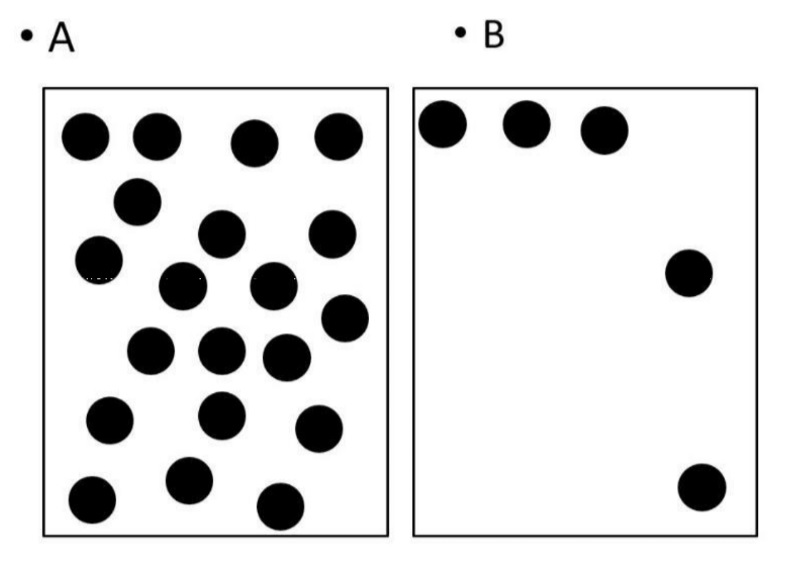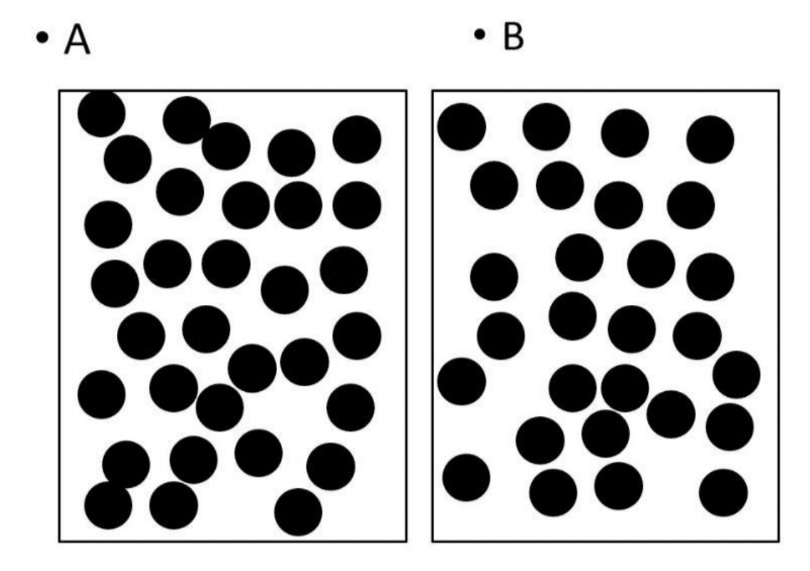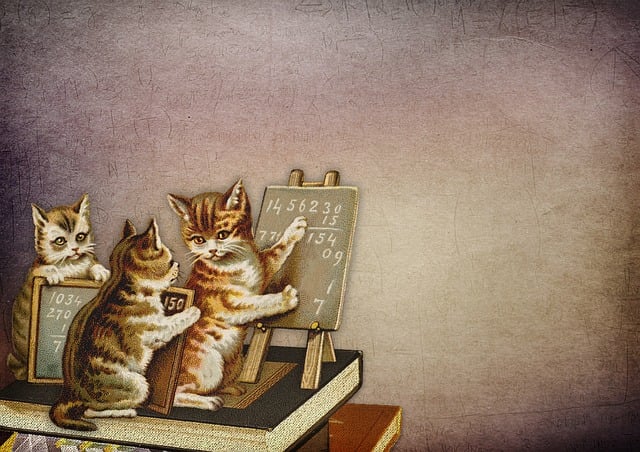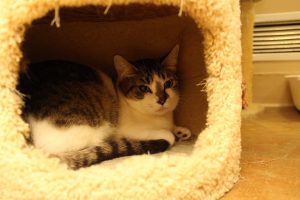Can kittens do math? Most, if not all, animals show the ability to perform a rudimentary form of math. We call the ability to tell between a smaller and a larger amount quantity discrimination. This “number sense” may help animals with important survival needs, including finding food (which patch has more berries?), avoiding conflict (which area has more predators present?), and reproducing (which male is larger?).
What is Weber’s Law?
The ratio between choices impacts the accuracy of quantity discrimination. This is a principle called Weber’s Law: the smaller the ratio, the easier it is to discriminate between amounts. For example, it is easier to identify the difference between 1 and 5 items (ratio 1:5 or 0.20), than between 4 and 5 items (ratio 4:5 or 0.80). Most animals are capable of discriminating between two amounts, but decision-making is slower and less accurate when the ratio is larger. This is true, even for humans! Try it yourself: which of these quantities can you discriminate between faster?


Adult cats can discriminate quantities!
I’ve previously reported on studies of adult cats’ ability to discriminate between larger and smaller amounts of shapes and quantities of food. A new study, Quantity discrimination by kittens of the domestic cat (Felis silvestris catus) looked at whether there are developmental effects on this ability. Most studies of quantity discrimination are in adult animals. It is largely unknown whether this ability is present in young animals or develops and improves over time.
Current study: Methods

In the study, 7-week-old kittens living in private foster homes in Mexico City were given two tests (at the end of the study, the kittens were adopted out into permanent homes). Food had been withheld for four hours before each testing session to ensure they were motivated to participate. Each kitten was placed on a box that was around 10” high, so they could have a good view of the apparatus. There were two trays in front of each kitten that were equidistant from the box. On one tray, there was a larger amount of cat food, and on the other tray, was a smaller amount of food. The experimenters randomly varied which side (right or left) had the larger amount of food, to control for any biases they kittens might have for going to the right or left.
The kittens were allowed to hop down from the box and approach whichever tray they preferred. If they interacted with the food in any way (e.g., licking, eating or touching the food), that was considered their choice.
Experiment 1
In Experiment 1, the kittens were given a choice between a larger and smaller number of food pieces. The ratios ranged from 3 to 4 (3:4 or 0.75, very large), to 1 to 9 (1:9 or 0.11, very small), with 12 ratios presented to each kitten. 26 kittens were tested; 25 of them chose the larger number of food pieces more often than would be expected by chance. Kitten 26 had no preference for the larger or smaller number of food pieces. The effect was especially strong when the ratio was less than 0.40 (e.g., 2 food pieces vs 5), demonstrating that for kittens, it was easier to discriminate between food quantities when the ratio was smaller.
Experiment 2
Experiment 2 was similar, but this time 24 kittens were presented with either a larger or smaller quantity of cat food that had been formed into a single “cookie” shape. Nine different ratios were tested, from 1 vs 5 to 4 vs 5. Eighteen of the kittens (75%) consistently chose the larger cat food “cookie.” Five kittens seemed to prefer the smaller cookie, and one kitten had no strong feelings either way. Although most kittens seemed to prefer the larger cookie, the effect was not as strong as in the first experiment. And interestingly, in the 1:5 ratio (where one cookie was five times larger than the other), kittens overwhelmingly chose the smaller amount.
Current study: Results!
The findings in kittens were very similar to those previously found in adult cats! Like in adult cats, when there was too large of a difference between the two stimuli, kittens preferred for the smaller amount. One possible explanation for this finding is that overwhelmingly, cats prefer smaller prey animals. A stimulus that is too big may be a cause to pause – perhaps larger prey is harder to manage, and it’s safer to go for a smaller quantity. Kittens also outperform similarly-aged puppies.
Kittens start hunting at a young age, and may need their quantity discrimination skills to kick in a lot earlier than a more group-living species. This study finds that by 7 weeks of age, kittens have similar quantity discrimination skills as they have as adults, suggesting that this ability is developmentally important!
References
Szenczi, P., Martínez-Byer, S., Chacha, J., Hudson, R., & Bánszegi, O. (2023). Quantity discrimination by kittens of the domestic cat (Felis silvestris catus). Animal Cognition, 1-8.
Bánszegi, O., Urrutia, A., Szenczi, P., & Hudson, R. (2016). More or less: spontaneous quantity discrimination in the domestic cat. Animal Cognition, 19, 879-888.
Miletto Petrazzini, M. E., Mantese, F., & Prato-Previde, E. (2020). Food quantity discrimination in puppies (Canis lupus familiaris). Animal Cognition, 23, 703-710.
Header photo from Darkmoon Art on Pixabay



